NR | 1 h 53 min | Musical, Comedy | 1944
A friendly intercity rivalry between Kansas City, Kansas and St. Louis, Missouri is the stuff of Midwestern folklore. But a cinematic tie binds them, too.

NR | 1 h 53 min | Musical, Comedy | 1944
A friendly intercity rivalry between Kansas City, Kansas and St. Louis, Missouri is the stuff of Midwestern folklore. But a cinematic tie binds them, too.